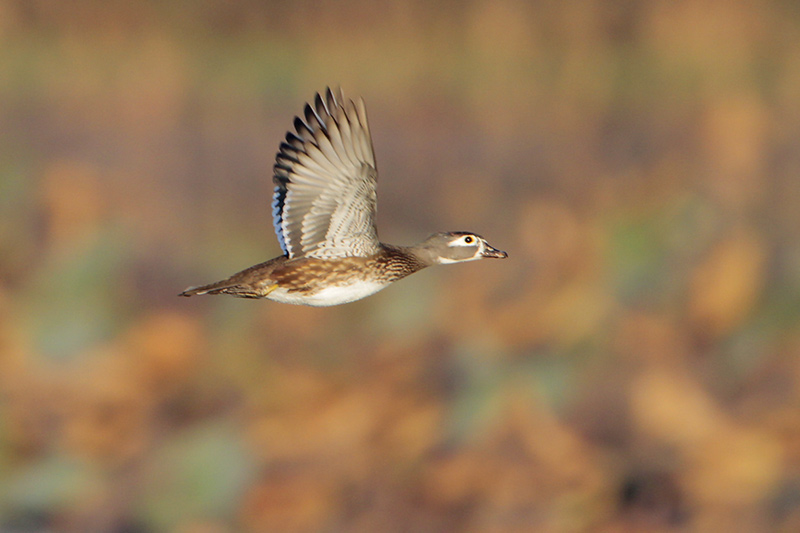
Female ducks are known as “hens” and male ducks as “drakes” because they look radically different from each other.
For most duck species, females are much duller than males and have plain plumage that helps camouflage them while nesting. Females of some duck species also look similar, and they often have dark, patterned marks on the head and around the eyes.
This may hide their eyes from potential predators, pecking by other ducks during territorial disputes, and might protect their eyes from glare commonly found in the aquatic habitats where they live.
On this page
Female vs Male Ducks
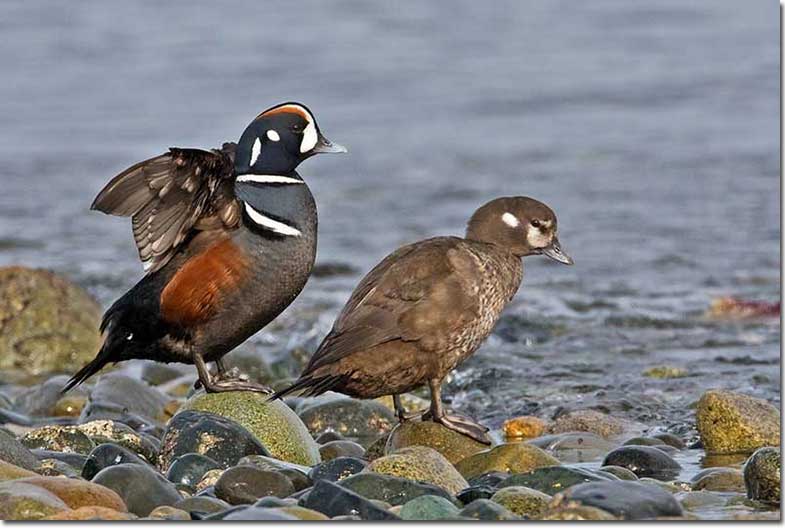
Similarly to other bird species, female ducks often have duller, brownish plumage.
Male and female ducks look very different, and some are so very different, at first glance, we might think we are looking at two species. For example, the male Common Eider is boldly patterned in black and white while the female is reddish-brown with small, dark markings.
Drakes are also a little bit bigger than hens, but those size differences are difficult to notice when watching them in the wild.
We find similar situations with other duck species, including the Mallard. The male of this common, “classic” duck has an orange-yellow bill, and a beautiful green head and upper neck separated from a rich brown breast by a narrow white band.
Related: The bizarre mating of ducks
The rest of the plumage is gray with some pale brown highlights, and the lower back and undertail is black. The short tail is white, and, like the hen, it has orange legs and feet. In flight, both sexes of the Mallard show a large, dark-blue patch in the wing bordered by two narrow white lines.
The female Mallard can be told from the drake by her mottled brown and buff plumage with dark markings on the top of the head, through the eyes and on the face, and a dark bill with an orange base and tip.
Scientific Information
Some comparisons between male and female ducks.
| Drakes | Hens | |
| Size | Larger, 20 -26 inches in length. Their weight averages 1.6 – 3.5 pounds but some weigh 15 pounds. | Smaller, 20 – 23 inches in length. Their weight averages 1.6 – 3.5 pounds but some can weigh 7 pounds. |
| Plumage | Drakes grow feathers later than hens and have colorful plumage. They also have curled tail feathers. | Hens have much duller, more camouflaged plumage and grow feathers earlier. They lack curled tail feathers. |
| Behavior | Drakes compete with other males and give elaborate courtship displays. | Hens are more active in general and lay eggs. |
| Sounds | Drakes are usually quieter than hens and have softer calls. | Hens are louder than males and give classic quacking calls, often in maternal situations. |
| Life Expectancy | The average life of drake ducks is 5 to 10 years, they tend to survive longer in the wild than females. | The average life of hen ducks is also 5 to 10 years, they don’t usually survive as long as males. |
Duller Plumage Compared to Males
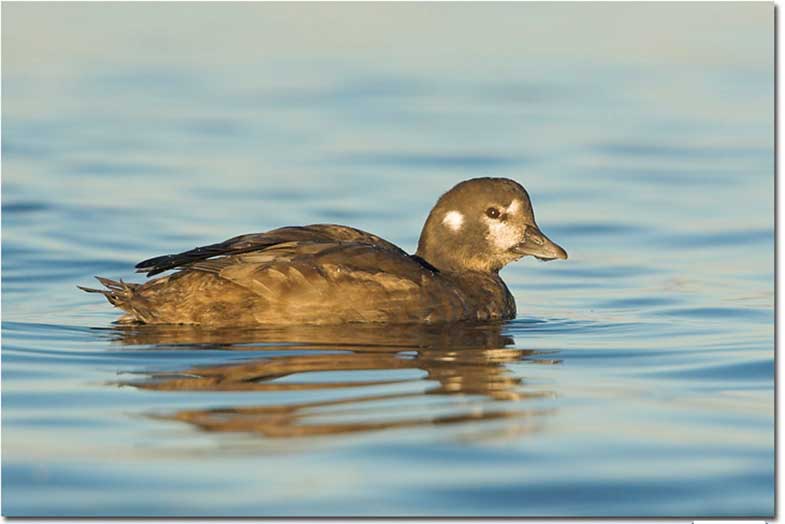
Female ducks are often easy to identify by their duller brownish plumage.
Female ducks are much duller than drakes. While males of most duck species have bold, contrasting black and white plumage or heads that can be reddish, green, or other colors, female ducks are patterned in shades of brown and buff.
In the case of the Mallard, one of the better known duck species, the hen is patterned in brown and buff with small dark markings. As with other duck species, this patterned plumage helps hide the female when she is most vulnerable; while she sits on her nest, incubating her eggs.
Behavior
The behavior of male and female ducks is pretty similar except when taking care of the young. Both sexes can squabble and fight over territories but males tend to fight more and do so by pecking, biting, hitting each other with wings, and pushing the other bird with their breast.
Related: What do ducks symbolize?
Although a pair will pick a nesting site, the female does all of the incubation and taking care of the young.
Tail
The shape of the tail doesn’t differ much between the sexes of most duck species but the color is often different. Drakes tend to have whiter or more colorful tails than the duller and more mottled tails of females.
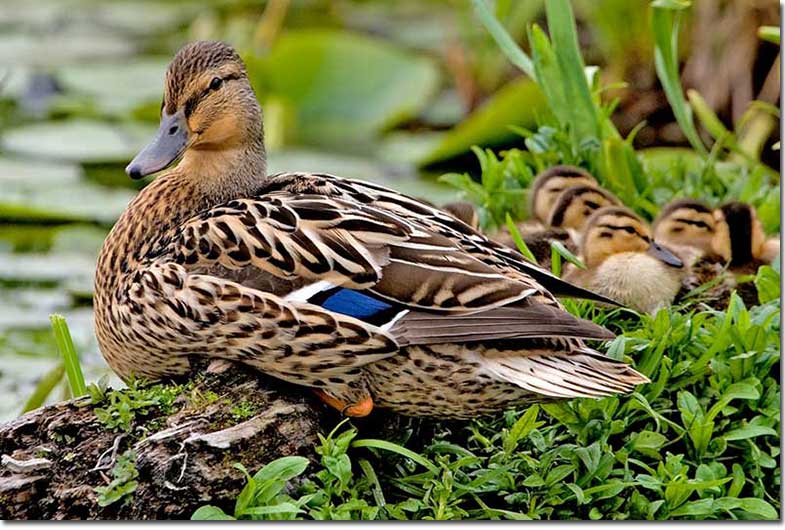
Female Mallards are perhaps most easy to identify.
In the case of the Mallard, the drake has a few glossy black curled feathers above its white tail whereas the female duck doesn’t any such ornamentation. She just has a brown mottled tail with some white highlights.
How to Tell a Younger Duck’s Gender
When ducks are young, it can be tough to tell which are hens and which are drakes. In the hand, the best way to know if a baby duck is a hen is to listen to it. Hens make loud quacking noises while males are quiet or make peeping sounds.
As they grow, other signs of a bird being a hen is more activity, smaller feet, and the lack of curled feathers above the tail. In the wild, when young Mallards are as big as adults but haven’t quite reached adulthood, the best way to tell females from males is to look at the bill.
If the bill is uniform greenish or yellowish, the bird is a male. The bills of young hen Mallards have a mottled dark and orange coloration.
Female Duck Lifecycle
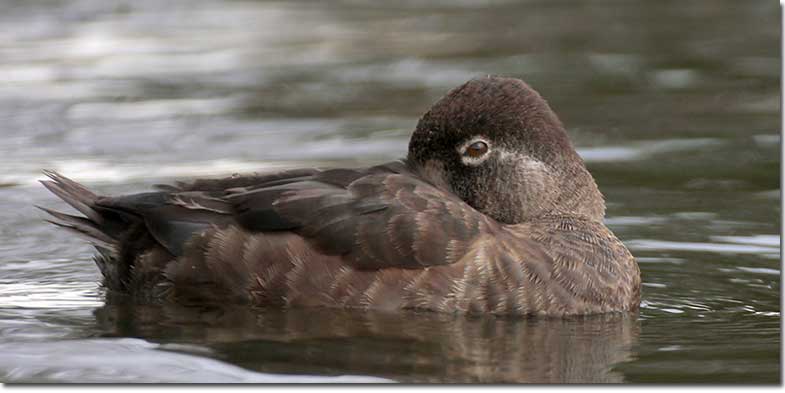
Female ducks are in charge of rising the young.
In captivity, ducks can lay eggs up to 300 times in a year. In the wild, most ducks lay eggs only once per year, but urban Mallards tend to have two nests. Ducks usually nest on the ground, usually in dense vegetation near water.
The female duck incubates one to a dozen eggs for 28 days. She spends much of that time sitting on the eggs, only taking short breaks to feed. When taking a break, she covers the nest with down feathers and a bit of vegetation.
After the eggs hatch, the young birds leave the nest shortly after but stay with their mother until they can fly (after 50 days). She leads them to water and tries to protect them from predators but sadly, baby ducks are vulnerable – less than 20% of their clutches ever hatch, and duckling mortality can run 50% or more.
Frequently Asked Questions About Female Ducks
What is a female duck called?
A female duck is called a hen.
How to tell if a duck is male or female?
A male duck has curled feathers above the tail, is quieter, and has more colorful plumages than a female duck.
Do female ducks lay eggs without a male?
Much like chickens, female ducks don’t need a male to lay eggs, but they won’t be fertilized.
Conclusions
Female ducks might not be as colorful as male ducks, but hens are louder, more active, and can lay 300 eggs a year, all on their own.
They can also be identified by their lack of curled tail feathers and duller, more mottled plumage.

